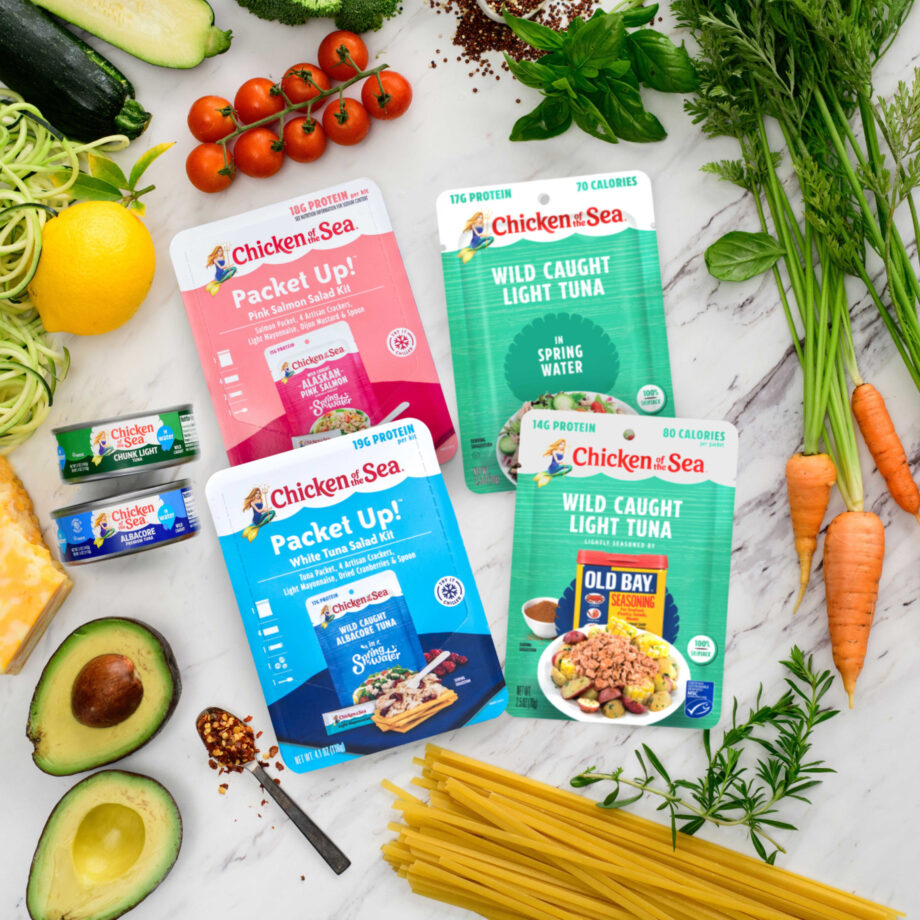Plus, it’s relatively inexpensive and can last for years in your cupboard.
Which is Better for You: Canned Tuna in Oil, Tuna in Water, or Fresh Tuna?
The three types of tuna–canned in oil, canned in water, and fresh– all have favorable nutritional profiles and contain similar amounts of protein, vitamins, and minerals. But as you can see in the nutritional table below, based on USDA data for a 1 oz. portion, each type excels in different ways.
| (1 oz Portion) | Canned Tuna in Oil (Low Sodium) | Canned Tuna in Water (Low Sodium) | Fresh Raw Tuna (Boneless) |
|---|---|---|---|
| Protein | 8 grams | 6 grams | 7 grams |
| Omega-3s |
DHA: 29 mg EPA: 8 mg |
DHA: 56 mg EPA: 8 mg |
DHA: 25 mg EPA: 3 mg |
| Vitamin B-12 | 0.6 µg | 0.7 µg | 0.6 µg |
| Vitamin D | 1.9 µg | 0.3 µg | 0.5 µg |
| Iron | 0.4 mg | 0.5 mg | 0.2 mg |
| Selenium | 21.5 µg | 19 µg | 26 µg |
| Phosphorus | 88 mg | 39 mg | 79 mg |
| Potassium | 59 mg | 50 mg | 125 mg |
| Total Fat | 2.3 grams | 0.9 grams | 0.14 grams |
| Saturated Fat | 0.4 grams | 0.2 grams | 0.05 grams |
| Cholesterol | 5 mg | 10 mg | 11 mg |
| Sodium | 118 mg | 70 mg | 13 mg |
| Calories | 56 | 24 | 31 |
Source: https://fdc.nal.usda.gov/fdc-app.html#/?query=tuna
As you can see, for many of these factors, the differences noted in this table are fairly small and/or the quantities are low for all three types. For example, fresh, raw tuna fish is naturally low in sodium and while not shown here, sodium-free or low-sodium tuna options are available. The versatility in flavor, species, and packaging of canned tuna can help you find the right choice based on your preferences.
Here are the top 6 health benefits of canned tuna:
1. Lean Protein Helps Support Healthy Muscles, Skin, and Bones
A four-ounce serving of canned tuna in water contains 24 grams of complete protein. And the same amount of canned tuna in oil brings a whopping 32 grams. It’s called a complete protein, because it has amino acids that your body can’t produce itself. These amino acids help you build muscles, skin, bones, and cartilage. Plus, protein keeps you feeling full longer than carbs which can help with weight loss.
2. Omega-3 Fatty Acids Support Heart Health
Canned tuna features omega-3 essential fatty acids DHA and EPA, which play a key role in the inflammatory pathways in the body as well as support a healthy heart, eyes and brain. For this and other reasons, the USDA recommends eating seafood at least two times a week for a total of 8-10 oz (but 90% of Americans don’t meet this guideline). Omega 3s are also a key advantage of a pescatarian diet over a vegetarian diet.
Tuna, mackerel, and sardines are all oily fish that offer a high content of omega-3 fatty acids, though they differ considerably in size and taste – with tuna having a relatively mild flavor and firm texture, mackerel possessing a stronger, richer taste, and sardines being small with a distinctively pronounced, fishy flavor – which influences how they are typically prepared and consumed.
3. Vitamin D Supports Bone and Immune Health
Tuna is one of the few foods that naturally contain vitamin D. Depending on the species, a 5 oz can of tuna can contain up to 10% of the Daily Value for Vitamin D. Vitamin D is very important for bone health because it helps our bodies absorb calcium. It also plays a role in supporting immune health.
4. Vitamin B-12 Supports Energy Metabolism and Your Red Blood Cells
Canned tuna also features vitamin B-12. On average, a can of tuna contains 2 micrograms of vitamin B-12, which equals approximately the recommended daily amount of vitamin B-12 for adults. Your body relies on B-12 to produce DNA, red blood cells, and other core functions.
5. Essential Minerals Help for Better Overall Health
Canned tuna contains many important minerals like iron, phosphorus, selenium, and potassium to support overall health and wellness. It’s a nutrient dense food in a tiny can!
6. Low in Fat
Canned tuna has less fat per ounce than other animal proteins like chicken and beef. Tuna salad calories and fat are higher, and oil-packed tuna contains more fat than water-packed, but a 1 oz serving of chunk light tuna in oil contains only 2.3 grams of total fat, while the same serving of chunk light tuna in water contains less than a gram.Higher fat levels also correlate to higher calories in a can of tuna: oil-packed tuna has 56 calories per ounce, which is more than double the calories in water-packed tuna.
So, as you can see, eating fish provides substantial nutritional benefits, and canned tuna is an excellent dietary source. The FDA Dietary Guidelines for Americans and many dietitians recommend eating 2-3 servings of fish or shellfish per week.
Types of Fish
Most canned or pouched tuna comes from skipjack, yellowfin, or albacore tuna. Light or chunk light tuna is typically a blend of skipjack and yellowfin tuna, sometimes including tongol or bigeye tuna. Albacore, known for its light-colored flesh, firm texture, and mild flavor, falls under the category of white tuna, which includes solid white and chunk white. Some people prefer it over light tuna for dishes that require a milder flavor and a firmer, more steak-like fish. According to the National Fisheries Institute, approximately 70% of canned and pouched tuna consumed in the United States is skipjack tuna (or a small amount of yellowfin), while about 30% is albacore.
What are Some Healthy Canned Tuna Recipes?
- Tuna Pasta Salad: Combine cooked pasta with drained tuna, mayonnaise, vegetables (like peas, celery, or carrots), and seasonings. Serve chilled. (full recipe)
- Tuna Veggie Grain Bowl: Combine cooked quinoa, tuna, sautéed cauliflower, zucchini, and asparagus. Top with cherry tomatoes, dill, and spicy mayonnaise. (full recipe)
- Mediterranean Tuna Salad: Combine drained tuna with halved cherry tomatoes, sliced Kalamata olives, chopped cucumber, and feta. Dress with lemon juice, olive oil, and oregano. (full recipe)
Frequently Asked Questions
How much protein is in tuna?
Tuna is an excellent source of protein. As shown above, canned tuna in oil contains 28 grams of protein per 113-gram serving. That’s approximately 50% of the daily recommended amount of protein for adults in a single serving!
Does tuna have more omega-3s than salmon?
No, tuna does not have more omega-3 fatty acids than salmon. A serving of salmon can contain as much as 1-2 grams of omega-3s, while tuna usually contains less than half a gram per serving. However, tuna still has omega-3s—you just have to eat it more frequently to meet your daily omega-3 requirements.
How often can you eat tuna?
The Food and Drug Administration and the EPA recommend eating 2-3 servings of fish or shellfish per week. Some people may be concerned about mercury content in tuna but the FDA states that the levels of mercury in fish pose minimal risk to most Americans. The FDA recommends that children between 1-11 years old and pregnant or breastfeeding women limit their tuna intake to 8-12 oz of light tuna or 4 oz of white tuna per week to limit potential mercury poisoning.
Can you eat tuna on a paleo or keto diet?
Yes, tuna is both paleo- and keto-friendly. Because it contains essentially zero carbohydrates, it fits easily into any high-protein diet. However, if you’re on a keto diet, you may want to choose oil-packed tuna because it’s higher in fat.
Is tuna good for your heart?
Yes, tuna is a great choice for a heart-healthy eating plan. It contains little to no saturated fat and plenty of unsaturated fatty acids. This includes omega-3 fatty acids, which support a healthy heart and cardiovascular system.
Are chunk light tuna and albacore tuna the same?
Nope! They refer to different species of tuna. Both chunk light and albacore tuna is good for you. Albacore refers to the albacore species, which has lighter, firmer meat than other species. Chunk light tuna contains different species, specifically skipjack and yellowfin. Nutritionally, they’re all very similar, but chunk light tuna is a bit darker in color and has a slightly richer flavor than albacore, which is very mild.
Sources:

Where to Buy
Overflowing with flavor, Chicken of the Sea packets and cans are ready for all your culinary adventures. Use our product locator to find the perfect salmon, tuna, crab or other seafood products from Chicken of the Sea.







